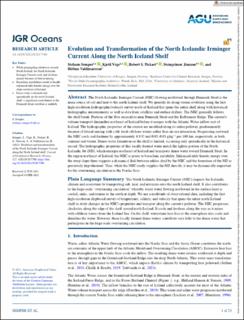| dc.contributor.author | Semper, Stefanie | |
| dc.contributor.author | Våge, Kjetil | |
| dc.contributor.author | Pickart, Robert S. | |
| dc.contributor.author | Jónsson, Steingrímur | |
| dc.contributor.author | Valdimarsson, Hedinn | |
| dc.date.accessioned | 2023-03-01T12:43:00Z | |
| dc.date.available | 2023-03-01T12:43:00Z | |
| dc.date.created | 2022-03-28T17:15:25Z | |
| dc.date.issued | 2022 | |
| dc.identifier.issn | 2169-9275 | |
| dc.identifier.uri | https://hdl.handle.net/11250/3054998 | |
| dc.description.abstract | The North Icelandic Irminger Current (NIIC) flowing northward through Denmark Strait is the main source of salt and heat to the north Iceland shelf. We quantify its along-stream evolution using the first high-resolution hydrographic/velocity survey north of Iceland that spans the entire shelf along with historical hydrographic measurements as well as data from satellites and surface drifters. The NIIC generally follows the shelf break. Portions of the flow recirculate near Denmark Strait and the Kolbeinsey Ridge. The current's volume transport diminishes northeast of Iceland before it merges with the Atlantic Water inflow east of Iceland. The hydrographic properties of the current are modified along its entire pathway, predominantly because of lateral mixing with cold, fresh offshore waters rather than air-sea interaction. Progressing eastward, the NIIC cools and freshens by approximately 0.3°C and 0.02–0.03 g kg−1 per 100 km, respectively, in both summer and winter. Dense-water formation on the shelf is limited, occurring only sporadically in the historical record. The hydrographic properties of this locally formed water match the lighter portion of the North Icelandic Jet (NIJ), which emerges northeast of Iceland and transports dense water toward Denmark Strait. In the region northeast of Iceland, the NIIC is prone to baroclinic instability. Enhanced eddy kinetic energy over the steep slope there suggests a dynamical link between eddies shed by the NIIC and the formation of the NIJ as previously hypothesized. Thus, while the NIIC rarely supplies the NIJ directly, it may be dynamically important for the overturning circulation in the Nordic Seas. | en_US |
| dc.language.iso | eng | en_US |
| dc.publisher | AGU | en_US |
| dc.rights | Navngivelse 4.0 Internasjonal | * |
| dc.rights.uri | http://creativecommons.org/licenses/by/4.0/deed.no | * |
| dc.title | Evolution and Transformation of the North Icelandic Irminger Current Along the North Iceland Shelf | en_US |
| dc.type | Journal article | en_US |
| dc.type | Peer reviewed | en_US |
| dc.description.version | publishedVersion | en_US |
| dc.rights.holder | Copyright 2022. American Geophysical Union | en_US |
| dc.source.articlenumber | e2021JC017700 | en_US |
| cristin.ispublished | true | |
| cristin.fulltext | original | |
| cristin.qualitycode | 2 | |
| dc.identifier.doi | 10.1029/2021JC017700 | |
| dc.identifier.cristin | 2013111 | |
| dc.source.journal | Journal of Geophysical Research (JGR): Oceans | en_US |
| dc.subject.nsi | VDP::Oseanografi: 452 | en_US |
| dc.subject.nsi | VDP::Oceanography: 452 | en_US |
| dc.identifier.citation | Journal of Geophysical Research (JGR): Oceans. 2022, 127 (3), e2021JC017700. | en_US |
| dc.source.volume | 127 | en_US |
| dc.source.issue | 3 | en_US |

